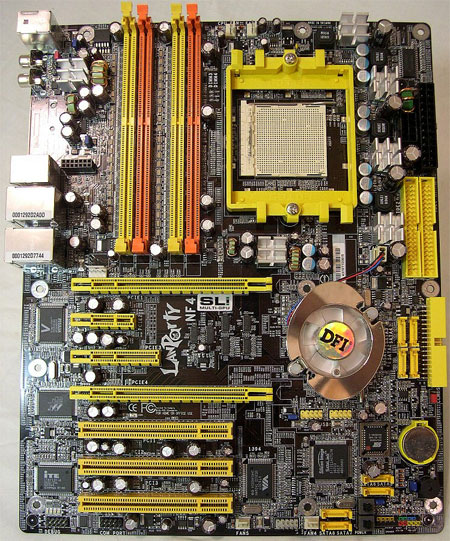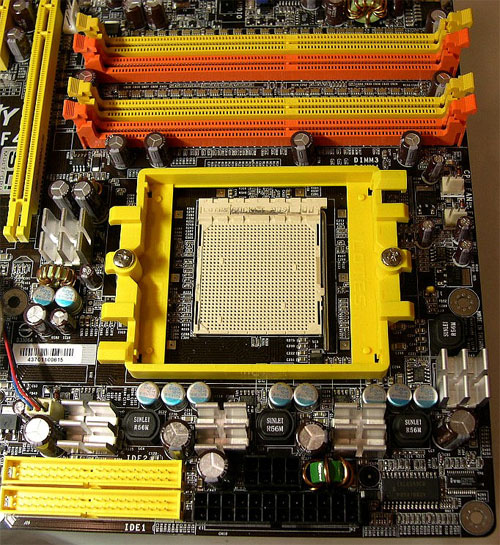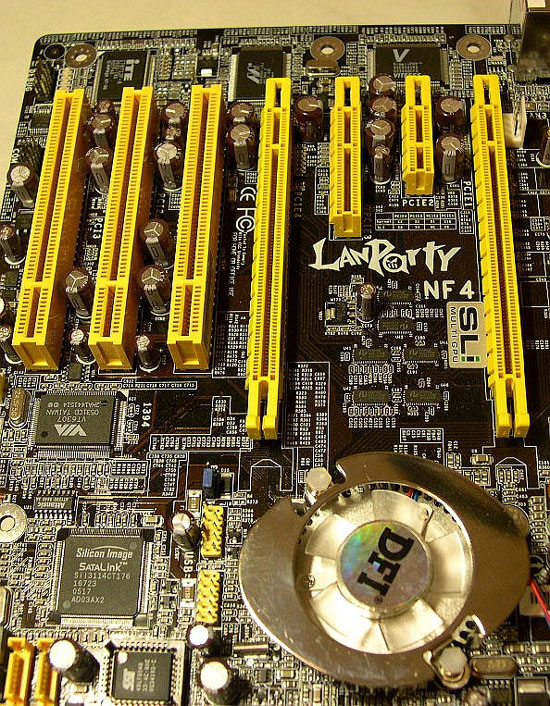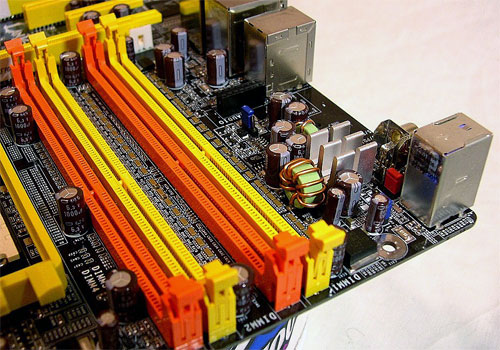DFI NF4 SLI-DR Expert – Can the best get better?
by Randi Sica on November 25, 2005 12:05 PM EST- Posted in
- Motherboards
DFI NF4 SLI-DR Expert: Feature Set
The SLI-DR Expert PCB is manufactured in DFI’s familiar black with UV reactive yellow color for the bulk of plastic components such as the PCI-e/PCI slots, IDE and Floppy connectors, and yellow and orange UV colors for the DIMM slots. The layout of components on this board is very good, with the IDE and Floppy connectors on the right side of the PCB, which generally works best in most cases. The trend recently has been to place floppy and/or an IDE at the bottom of the PCB, and it’s refreshing that DFI has shied away from this practice.
The original 4-pin Molex and the 4-pin P4 style connector have been replaced by an 8-pin 12V power connector placed next to the 24-pin ATX connector. During setup of the board, we came to realize that the PC Power and Cooling Turbo-Cool 510 SLI PSU on our review bench does not include this new style 12V plug, so we utilized the standard 4-pin 12V plug, which fit fine on one side of the 8-pin connector. We saw no ill effects on stability from using the 4-pin instead of an 8-pin connector. The 4-pin floppy-type connector for video remains above the 1st x16 PCI-E slot as was provided on the original SLI-DR.
The SATA 5, 6, 7 and 8 ports are controlled by the Silicon Image SIL 3114, which (to be honest) is a disappointment. With the SIL 3132 available, it would have made sense to include that SATAII controller, which would have given this board 8 SATAII channels and thus keeping this board future-proof and flexible. This omission is a hard one to figure out based on the many changes made on of this board, considering the current proliferation and wide availability of SATAII hard drives.
IEEE 1394 Firewire is controlled by the familiar VIA VT6307. Audio is provided by their Karajan 8 Channel audio card utilizing the AC97 codec, again the same setup as the previous generation. The board also boasts momentary switches for Power on and Reset like its previous version, along with the Vitesse and Marvel Gigabit Ethernet controllers.
The most obvious change is the 90 degrees counter-clockwise rotation of the CPU and memory. This layout was first seen on the DFI ATI based RDX200 CF-DR just recently introduced, and carried over to the Expert.
Compared to the original SLI-DR, the Expert includes some major changes in its design. In a conversation with OCZ Technology’s guru, Tony Leach, an expert in memory interfaces and BIOS, Tony pointed out: “The changes I know about fall mainly with memory drive strength. Engineer Oskar Wu has added even more resistors this time to allow near full drive from the memory controller. He also has routed the traces for the DIMMs over 4 layers to cut crosstalk to the bare minimum. DFI also use similar power regulation to the ATI reference boards, which I helped spec.”
The CPU power section includes the superb Nichicon capacitors to complement DFI’s overall use of high quality Japanese capacitors throughout the board. The major change here was the move to a 4-phase PWM power section as has been used on Intel based P4 boards for a number of years. 4 Phase power, through its ability to provide clean stable power, is noted for providing increased CPU, and hence, system stability. As has been the norm in DFI’s current lineup, inclusion of heat sinks on all MOSFETs is a nice touch and very effective.
Another major change in the Expert board is its x16 PCI-E slots. They have been moved farther apart, which facilitates the use of improved cooling. Graphics card coolers such as those manufactured by Arctic Cooling and others, certain types of water blocks, and phase change evaporators were very difficult or impossible to use on the original DFI as there just wasn’t enough room to use them. The additional spacing opens up the ability for end-users to use alternative cooling methods.
The other change involves the elimination of the SLI jumper system from the original SLI-DR. The original jumper system was a bit of headache to perform and is now switched from within the BIOS.
The only criticism that currently remains involves the northbridge fan, which cannot be avoided based on the board’s layout. Long graphics cards such as the NVIDIA 6800Ultra and 7800GTX can contact the fan housing.
The fan itself is a magnetic levitation design and is quiet and effective, a nice carry-over from the original SLI-DR.
This view illustrates the power section of the memory subsystem. Of note here is the addition of an Inductor and several additional capacitors, again, to provide the utmost in stability. The most apparent change is the elimination of the previous generation’s vDIMM jumper that allowed an end-user to switch the power supply provided from the 3.3V line to the 5V line. This, of course, allowed you to have at your fingertips 4V+ to apply to your RAM modules, especially modules such as BH-5, which required it to run 260 MHz+ with tight timings. The option to use 4V+ remains with this revision, but it is now simply a matter of just adjusting the memory voltage in the BIOS.
| DFI LP UT NF4 SLI-DR Expert | |
| CPU | . AMD® Athlon 64 X2 / Athlon 64 FX / Athlon 64 / Sempron . Socket 939 |
| Chipset | . NVIDIA nForce4 SLI - Supports NVIDIA SLI (Scalable Link Interface) |
| Front Bus Speeds | . 2000MT/s HyperTransport interface |
| Memory | . Four 184-pin DDR SDRAM DIMM sockets . Supports dual channel (128-bit wide) memory interface . Supports up to 4GB system memory . Supports PC2100 (DDR266), PC2700 (DDR333) and PC3200 (DDR400) DDR SDRAM DIMM |
| SLI / Single VGA Mode | . SLI mode - Use 2 SLI-ready PCI Express x16 graphics cards (identical cards) on the PCI Express x16 slots. - Each x16 slot operates at x8 bandwidth. When the graphics cards are connected via the SLI bridge, the total bandwidth of the two graphics cards is x16. . Single VGA mode - 1 PCI Express graphics card on the PCIE1 slot operates at x16 bandwidth. - The other PCI Express x16 slot (PCIE4) operates at x2 bandwidth. |
| BIOS | . Award BIOS . CMOS Reloaded . CPU/DRAM overclocking . CPU/DRAM/Chipset over-voltage . 4Mbit flash memory |
| Power Management | . Supports ACPI STR (Suspend to RAM) function . Wake-On-Events include: - Wake-On-PS/2 Keyboard/Mouse - Wake-On-USB Keyboard/Mouse - Wake-On-LAN - RTC timer to power-on the system . AC power failure recovery |
| Hardware Monitor | . Monitors CPU/system/chipset temperature . Monitors12V/5V/3.3V/Vcore/Vbat/5Vsb/Vchipset/Vdram voltages . Monitors the speed of the CPU fan, Fan 2 and Fan 3 - fan CPU Overheat Protection function monitors CPU temperature during system boot-up |
| FSB Frequency | 200Mhz-550Mhz in 1 Mhz increments |
| LDT Multiplier | Auto, 1X to 5X |
| USB 2.0 | . 6 USB 2.0/1.1 ports |
| Expansion Slots | . 2 PCI Express x16 slots . 1 PCI Express x1 slot . 1 PCI Express x4 slot . 3 PCI slots |
| Onboard SATA II/RAID | . Four Serial ATA ports supported by the nForce4 SLI chip - SATA speed up to 3Gb/s - RAID 0, RAID 1, RAID 0+1 and JBOD - NVIDIA RAID allows RAID arrays spanning across Serial ATA and Parallel ATA . Four Serial ATA ports supported by the Silicon Image Sil 3114 chip - SATA speed up to 1.5Gb/s - RAID 0, RAID 1, RAID 0+1 and RAID 5 |
| Onboard IDE | . Supports two IDE connectors that allows connecting up to four Ultra DMA 133Mbps hard drives . NVIDIA RAID allows RAID arrays spanning across Serial ATA and Parallel ATA . RAID 0, RAID 1, RAID 0+1 and JBOD |
| IEEE 1394 | . VIA VT6307 . Supports two 100/200/400 Mb/sec ports |
| Onboard LAN | . Dual Gigabit LAN - Vitesse VSC8201 Gigabit PHY and Marvell 88E8001 Gigabit PCI . Fully compliant to IEEE 802.3 (10BASE-T), 802.3u (100BASE-TX) and 802.3ab (1000BASE-T) standards |
| Onboard Audio | . Karajan audio module - Realtek ALC850 8-channel AC'97 audio CODEC - 6 audio jacks - 1 CD-in connector - 1 front audio connector . True stereo line level outputs . S/PDIF-in/out interface |
| BIOS Revision | Award (11/2/2005) Shipping Bios |
The SLI-DR Expert PCB is manufactured in DFI’s familiar black with UV reactive yellow color for the bulk of plastic components such as the PCI-e/PCI slots, IDE and Floppy connectors, and yellow and orange UV colors for the DIMM slots. The layout of components on this board is very good, with the IDE and Floppy connectors on the right side of the PCB, which generally works best in most cases. The trend recently has been to place floppy and/or an IDE at the bottom of the PCB, and it’s refreshing that DFI has shied away from this practice.
The original 4-pin Molex and the 4-pin P4 style connector have been replaced by an 8-pin 12V power connector placed next to the 24-pin ATX connector. During setup of the board, we came to realize that the PC Power and Cooling Turbo-Cool 510 SLI PSU on our review bench does not include this new style 12V plug, so we utilized the standard 4-pin 12V plug, which fit fine on one side of the 8-pin connector. We saw no ill effects on stability from using the 4-pin instead of an 8-pin connector. The 4-pin floppy-type connector for video remains above the 1st x16 PCI-E slot as was provided on the original SLI-DR.
The SATA 5, 6, 7 and 8 ports are controlled by the Silicon Image SIL 3114, which (to be honest) is a disappointment. With the SIL 3132 available, it would have made sense to include that SATAII controller, which would have given this board 8 SATAII channels and thus keeping this board future-proof and flexible. This omission is a hard one to figure out based on the many changes made on of this board, considering the current proliferation and wide availability of SATAII hard drives.
IEEE 1394 Firewire is controlled by the familiar VIA VT6307. Audio is provided by their Karajan 8 Channel audio card utilizing the AC97 codec, again the same setup as the previous generation. The board also boasts momentary switches for Power on and Reset like its previous version, along with the Vitesse and Marvel Gigabit Ethernet controllers.
The most obvious change is the 90 degrees counter-clockwise rotation of the CPU and memory. This layout was first seen on the DFI ATI based RDX200 CF-DR just recently introduced, and carried over to the Expert.
Compared to the original SLI-DR, the Expert includes some major changes in its design. In a conversation with OCZ Technology’s guru, Tony Leach, an expert in memory interfaces and BIOS, Tony pointed out: “The changes I know about fall mainly with memory drive strength. Engineer Oskar Wu has added even more resistors this time to allow near full drive from the memory controller. He also has routed the traces for the DIMMs over 4 layers to cut crosstalk to the bare minimum. DFI also use similar power regulation to the ATI reference boards, which I helped spec.”
The CPU power section includes the superb Nichicon capacitors to complement DFI’s overall use of high quality Japanese capacitors throughout the board. The major change here was the move to a 4-phase PWM power section as has been used on Intel based P4 boards for a number of years. 4 Phase power, through its ability to provide clean stable power, is noted for providing increased CPU, and hence, system stability. As has been the norm in DFI’s current lineup, inclusion of heat sinks on all MOSFETs is a nice touch and very effective.
Another major change in the Expert board is its x16 PCI-E slots. They have been moved farther apart, which facilitates the use of improved cooling. Graphics card coolers such as those manufactured by Arctic Cooling and others, certain types of water blocks, and phase change evaporators were very difficult or impossible to use on the original DFI as there just wasn’t enough room to use them. The additional spacing opens up the ability for end-users to use alternative cooling methods.
The other change involves the elimination of the SLI jumper system from the original SLI-DR. The original jumper system was a bit of headache to perform and is now switched from within the BIOS.
The only criticism that currently remains involves the northbridge fan, which cannot be avoided based on the board’s layout. Long graphics cards such as the NVIDIA 6800Ultra and 7800GTX can contact the fan housing.
The fan itself is a magnetic levitation design and is quiet and effective, a nice carry-over from the original SLI-DR.
This view illustrates the power section of the memory subsystem. Of note here is the addition of an Inductor and several additional capacitors, again, to provide the utmost in stability. The most apparent change is the elimination of the previous generation’s vDIMM jumper that allowed an end-user to switch the power supply provided from the 3.3V line to the 5V line. This, of course, allowed you to have at your fingertips 4V+ to apply to your RAM modules, especially modules such as BH-5, which required it to run 260 MHz+ with tight timings. The option to use 4V+ remains with this revision, but it is now simply a matter of just adjusting the memory voltage in the BIOS.















40 Comments
View All Comments
Hardass1 - Sunday, February 19, 2006 - link
Another well done review Sir.Hardass.
lopri - Saturday, November 26, 2005 - link
If you had to pick one, which one would you pick? A8N32-SLI or Expert? Please don't tell me "Both are good", "They're different animals" or anything in that sense. Most of us have to pick ONE and that exact question is what we want to know. I'd venture to say what matters are following two:1. Overclockability
2. Stability
Fetures, layouts, etc... yeah.. they are all good and nice, but what really matters are whether the overclock is stable. And that's what brought DFI here today. Could you comment on it? If you had a choice to pick JUST ONE, which one would you pick?
Great review anyway. I'm actually happy that AT is becoming more enthusiast-friendly and looking forward to the next review. (Possibly Opteron Overclocking review?)
Thanks.
lop
RSica - Sunday, November 27, 2005 - link
Hi Lop:)I'll be honest in telling you I have not had my hands on the Asus board to know it's full overclocking abilities, so I really can't give you an opinion on which board to choose. Wesley could give you full insight on that one.
I go way back in the overclocking business, having hooked up with my best buds OPPAINTER and DDTUNG back in the day. At that time we were modding and overclocking each generation of Abit AMD based boards starting with the KG7 and culminating with the NF7-S, which we were pre-production testing prior to it's retail release. I've also had a play with Epox, Gigabyte, and the famous Shuttle A64 board.When I recieved the original SLI-D back in January it was an overclockers dream come true.All the voltage and overclocking/memory options and it overclocked way easy compared to the norm.(Thank you Oskar Wu:))
The Expert is more of the same but much better. I am a bit biased on a personal level about the board, and if you had just asked about it, I'd have given a thumbs up.
Thanks for your comments !
Randi
Scrith - Wednesday, November 30, 2005 - link
Does this use the same chipset as the A8N32-SLI? If not, why not, and where are the competitors for that board?Heckler 5th - Sunday, December 4, 2005 - link
how come the box the reviewer received already has that "anandtech gold medal" sticker on there? hmmm, kinda fishy... LOLcbkia - Saturday, November 26, 2005 - link
Under the extreme oc page, the pic showing the HTT @ 400MHz and RAM @ 300MHZ 2.5-3-3-8 but the sisoft is only 6674 MB/s? 300MHz should be displaying something near 8GB/sRSica - Sunday, November 27, 2005 - link
That would be true if not running at 2400Mhz.All HTT and Memory overclocking tests were done at a reduced multiplier. Each multiplier also has an effect on system bandwidth in the way the A64 responds to them.If I had chosen to run 7 and a total CPU Mhz of 2800, you would have most likely seen the 8000mb/s figure.In contrast, the stock 4000+ at 12x200Mhz with tight timings will average 5600-5700mb/s.
Another consideration is that with the bios used which made it more ram overclocking friendly, that there was possibly a relaxation of some of the bios register settings, which can also reduce bandwidth a bit in the name of pushing the memory higher in Mhz.
Thanks for your comments !
Randi
RobFDB - Saturday, November 26, 2005 - link
What i'm really interested in is if this board suffers from the same problem as my Ultra-D with PC4000 VX memory (the infamous cold boot issue)?I don't really want to pick this board up and have it suffer from the same problem. Not that i've tried my VX with the latest beta bios, but that's besides the point.
RobFDB - Tuesday, November 29, 2005 - link
Can anyone confirm or deny that the cold boot issue exists with this board?yacoub - Saturday, November 26, 2005 - link
If it had passive cooling like the A8N32-SLI I'd be more interested.